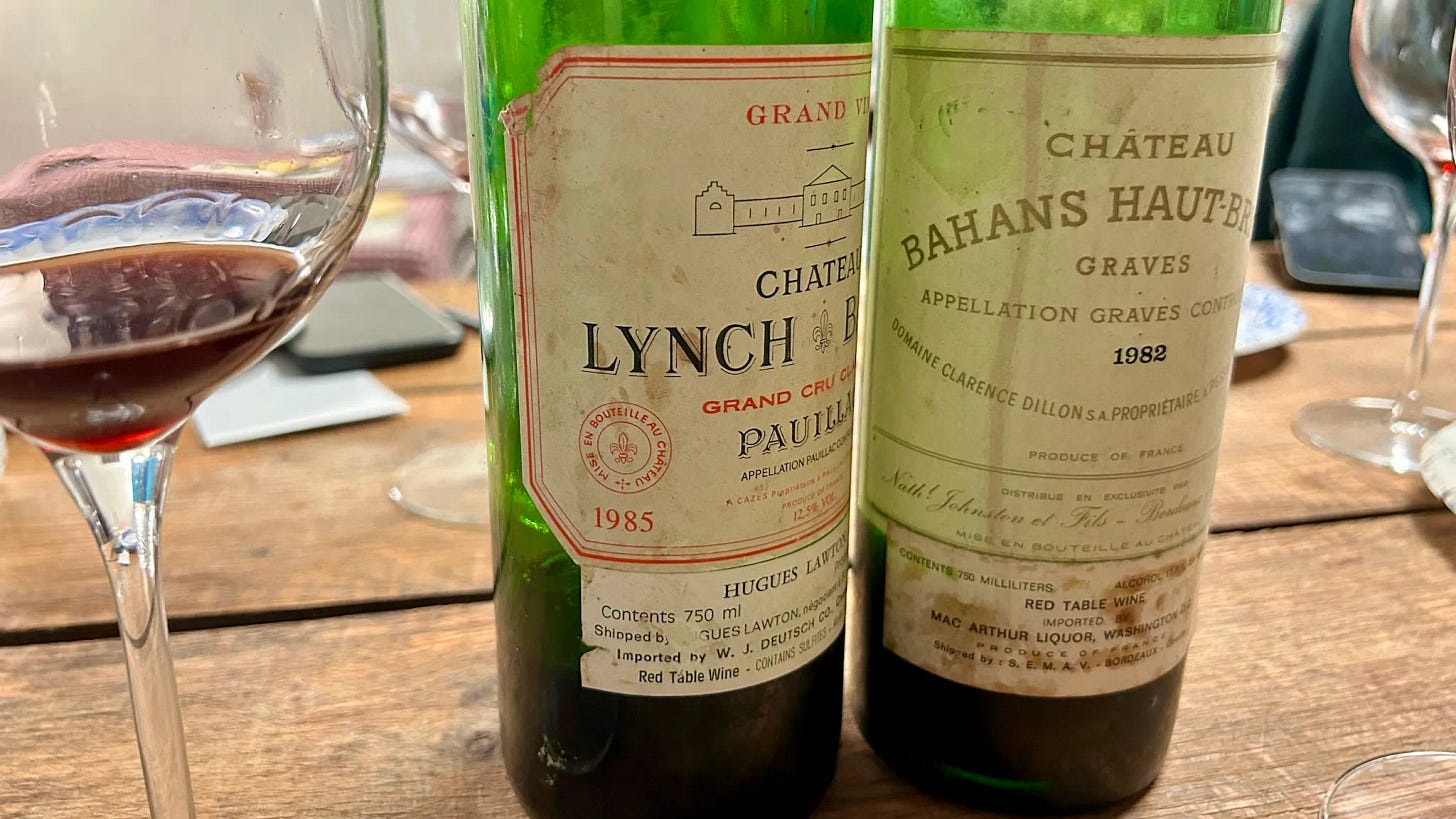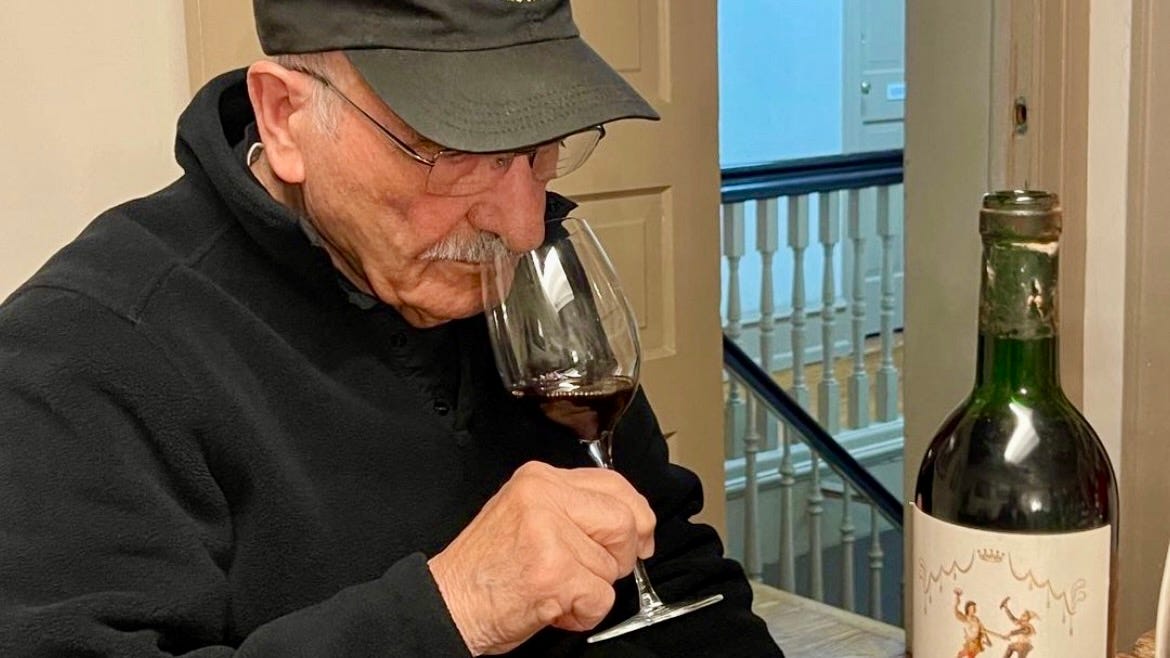"I Had A Guy": An Unfussy Tasting Of 1980s Bordeaux
Bordeaux wasn’t always like it is now. Not so long ago, even normal people could afford to buy and cellar its best wines.
This first appeared in The New Wine Review.
A few weeks ago, I attended a tasting of Bordeaux wines from the 1980s. This wasn’t in a fancy tasting room or a Michelin-starred restaurant, hosted by a master sommelier. No. It happened at a table in my cramped office, in a small town in South Jersey, where my friend David Avedissian and his 86-year-old father, Pierre, generously shared a few bottles from their cellar.
The Avedissians are not billionaire collectors. David is a local attorney, and Pierre, for many years, ran a hair salon in our town. At some point in the early 1980s, Pierre decided to start buying Bordeaux—perhaps as a remembrance of growing up in France, from where he emigrated at age 17. “Actually, I don’t know that much about wine,” he admitted, with a laugh. In fact, during the early 2000s, before David had any interest in wine, Pierre nearly sold his entire collection. “I was ready to sell it all to a guy,” he said. “But the guy never came to get it. I waited. After about four years, I decided to keep it and give it all to David”—who has since extended and deepened the collection.
After tasting through their amazing bottles, I gotta say: I am deeply grateful that guy, whoever he was, never showed up.
Which makes me sort of a hypocrite. In my book, Godforsaken Grapes, which advocates for obscure wines from lesser-known places, high-end Bordeaux is one of the main villains—along with critics like Robert Parker and other gatekeepers of a status-quo wine hierarchy. In a chapter called “Château du Blah Blah Blah,” I tell how I was once humiliated during a tasting with Prince Robert de Luxembourg, managing director of Château Haut-Brion, whose attitude seemed to be: “How the hell did you get an appointment with me?” Of my tasting with the prince, I wrote, “I haven’t felt so foolish since middle school when I forgot to wear shorts to a basketball game, and pulled down my sweatpants to reveal my tighty-whities to the crowd.”
Contemporary high-end Bordeaux can so easily represent everything wrong with wine—its pretension, its bloated prices, its power over critics and discourse, its showy, high-alcohol wines, its focus on a handful of estates coasting on prestige bestowed during the Second French Empire in the mid-19th century, its inaccessibility to younger wine enthusiasts.
But here’s the thing: It wasn’t always like this. Not so long ago, many people could afford to buy and cellar good Bordeaux wines. The 1980s, when Americans first got excited about wine, coincided with several excellent Bordeaux vintages, including 1982, 1985, 1986, and 1988. Much of which you could purchase at your local wine shop: no futures, no allocations, no auctions, no nonsense.
Pierre acquired much of his collection at one liquor store in Cherry Hill, New Jersey, one that also sold cigarettes and lottery tickets. “I got lucky,” Pierre said. “When I first built my wine cellar, that’s when the 1982s were just coming out. At the time, they were saying ’82 was a good vintage. But it ended up being one of the best.”
That was, of course, long before the advent of niche wine stores staffed by people studying for advanced WSET certifications. But you could still occasionally find a knowledgeable, passionate wine person in a standard-issue liquor store. “I was lucky that I had a guy,” Pierre said. “I used to subscribe to the Wine Spectator, and I had a wine encyclopedia. But the guy at my local store knew what was good.”
Our group at the tasting spanned several generations. David and I are Gen Xers. Our friends Mike and Alexa, a millennial couple just starting to collect wine, came over, as did our friend John, a young boomer who also has a solid collection of Bordeaux. John brought a selection of cheeses worthy of these wines—Pierre insisted that there be brie: “the very best pairing with Bordeaux”—and we sipped a pleasant pre-game 2015 Bordeaux Supérieur from Château Labatut ($15) while we waited for Pierre and David to fiddle with the corks. I put on a playlist that was heavy on ‘80s synths.
We began with a 1982 Château Bahans Haut-Brion (known today as Le Clarence), the second label of First Growth Château Haut-Brion. This was a dive into the deep end of well-aged Bordeaux: at first earthy and musky, then opening up with aromas of cedar and leather, and deep flavors of olive and pepper, mellowed, silky tannins, and a pretty good finish. It elicited nods of approval throughout the room. “I always want a little bit of earthiness with old Bordeaux,” David said. “I want the olive. I want the cedar.”
“My tasting note is ‘tapenade,’” said John.
For Mike and Alexa, this was the first time they’d tasted such an old wine, and they grew quiet as they wrapped their heads around these flavors and aromas. Alexa noted that its vintage was only a year younger than her. Meanwhile, Pierre sounded a little unimpressed. “I think I like the 2015 better,” he said, chuckling, as he cut another hunk of brie.
A couple of things about the Bahans Haut-Brion impressed me. It was incredible how much freshness this four-decade-old wine still displayed. Also, at a mere 11.5% abv, it’s noteworthy how completely different the drinking experience was compared to the 14.5% hammers now routinely found throughout Bordeaux. It still had great energy, even if it might be slightly in decline and walked with a slight limp, or a cane. Also noteworthy: the price. In the mid 1980s, Pierre bought this Bahans Haut-Brion for around $20, which would be about $63 today. Compare that to the 2022 Le Clarence, which runs around $180.
1982 famously established Robert Parker’s reputation. Almost all other critics declared 1982 in Bordeaux to be a poor year, too ripe and too low in acidity. But Parker effusively praised the vintage—and especially bottles from Second, Third, Fourth, and Fifth Growth producers that, in those years, were still very gently priced. Whatever people think of critics like Parker now, his predictions on the 1982 vintage were totally correct, and it became wildly sought-after.
So, in a way, the omnipresence of the 100-point scale—the legacy of which, many argue, burdens the wine world today—stems from the ageworthiness of Bordeaux’s 1982 vintage. We may be in the waning days of both the 1982 vintage and scores. This may be a generalization, but I’ve tasted a number of 1982s over the past few years, and while there’s still freshness and drinkability, many bottles at this stage have slipped past their prime. Some of this may be how the wines I’ve tasted have been cellared. But I also wonder whether that rich, ripe vintage (which predated many modern growing and winemaking techniques) is finally entering its decline. If you have 1982s, I’d open them now.
The wines at this tasting had been cellared well. Pierre does not have a fancy, custom-made wine cellar. “It’s all natural, three sides dirt and one stone wall. When I built the house, it was going to be a crawl space, but I said, ‘No, no, let’s make it a wine cellar.’” He added: “I’ve never had a bad bottle that’s been stored there.”
As good as the Bahans Haut-Brion had been, the next bottle—1985 Château Lynch-Bages—was the wine of the night. It’s drawn raves pretty much since it was released. (Wine Spectator named it their No. 1 wine of the year in 1988.) Given that, it’s somewhat surprising that Lynch-Bages, from Pauillac, is a Fifth Growth, not a Premier Cru. In the 1980s, critics used this bottle as an example for Americans, many of whom were new to wine collecting, to look for value outside of Bordeaux’s traditional hierarchy. In that era, Pierre bought his for under $40, or around $100 in today’s dollars. Today you’ll find the 1985 Lynch-Bages selling for around $400. The 2022 vintage’s release price, by contrast, is $140.
It’s the second time I’ve had this wine—the first was maybe five or six years ago—and it still sings beautifully. It starts with deep, dark forest floor notes, then moves to cedar, smoke, leather, and mint. An amazing, youthful core of fresh black and red fruit persists, with a hint of elegant tannins and a long savory finish. It’s seamless, and it’s everything that people who love old Bordeaux desire.
Critics at Decanter, Vinous, and Wine Advocate all revisited this wine in 2023 and all raved about its staying power. Decanter perhaps said it best: “It is tough to put into words how much I love this wine…In the two dozen or so times that I have drunk this wine it has never been anything short of spectacular.” The writer added: “There is no benefit from waiting, but there is also no rush.”
At my office table, our tasting discussion was light on tasting notes, and high on superlatives. “Normally, I prefer Bordeaux at around 10 years,” said David, “But this is amazing.”
Even Pierre was impressed by this one. “I thought I was losing my sense of taste,” he said. “But tasting this, wow. Clearly, I am not.”
“I’ve never tasted anything like this,” said Mike. As a new collector, he wanted to know: How would he even begin to start building a cellar with bottles like this? Hundreds of dollars for already-aged bottles would be out of the question. Our advice was both simple and complicated: Find the wines from regions and grapes that will last, and may someday increase in value. Which led Mike to ask: How do I know what wines those will be? We all shrugged. More than anything else, we said, buy wines that bring you joy—so much joy that you’re willing to save some of that joy for later.
Aging, after all, is what separates wine from almost all other consumable goods. Since Roman times, aging has defined wine’s elevated place in the culture. But it’s complicated. A dark art. It takes time and patience.
It also takes luck. Sometimes, you have to know a guy. Other times, you have to hope the other guy never shows up.



